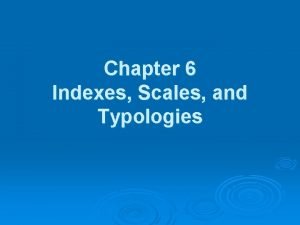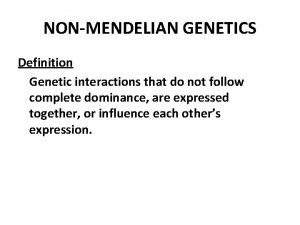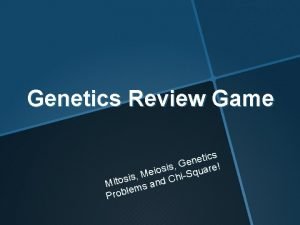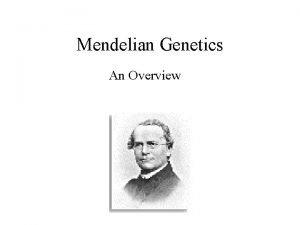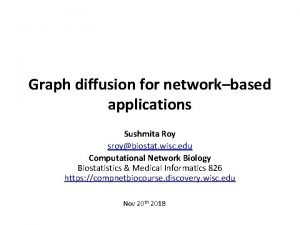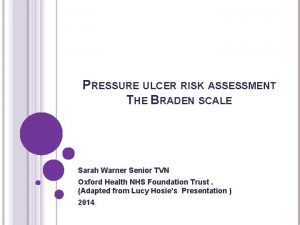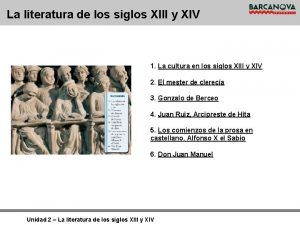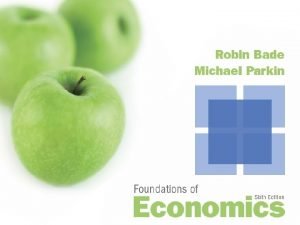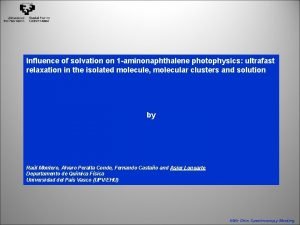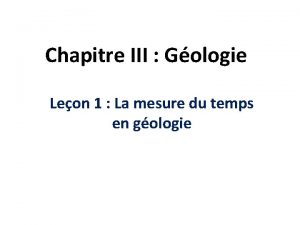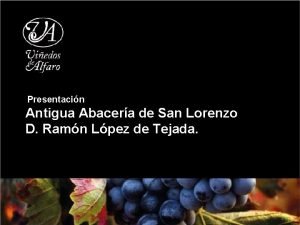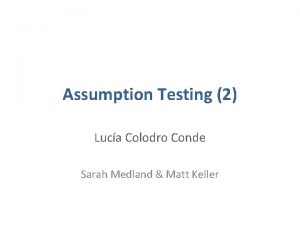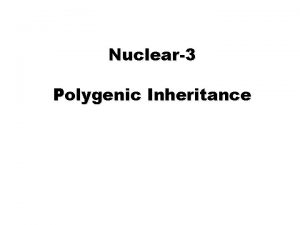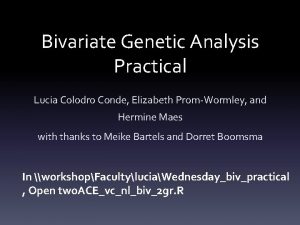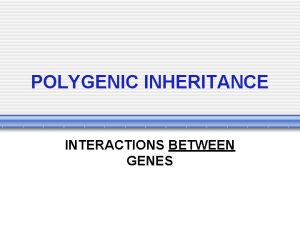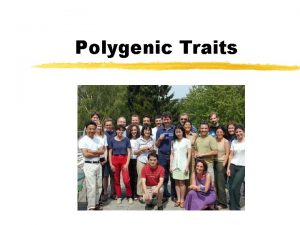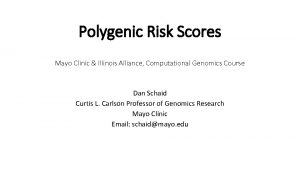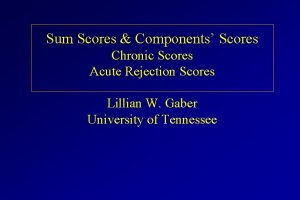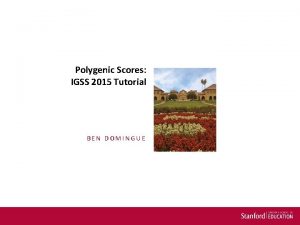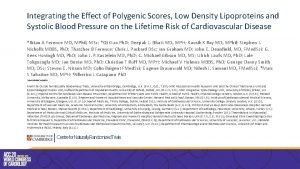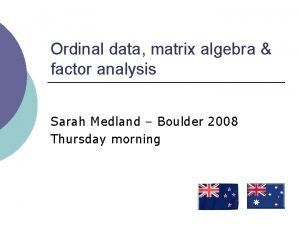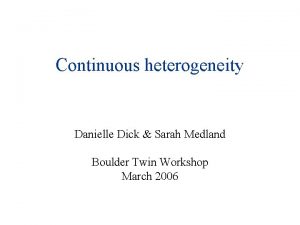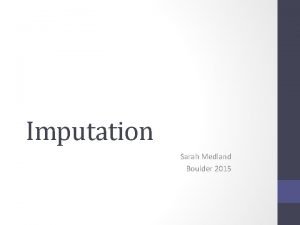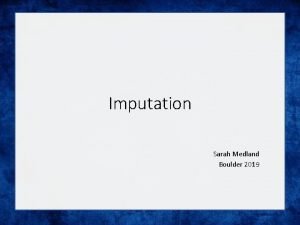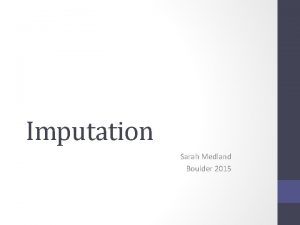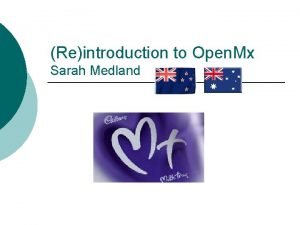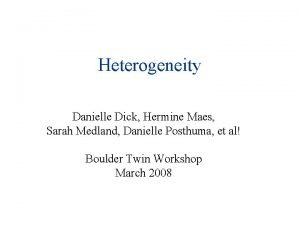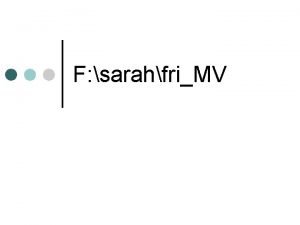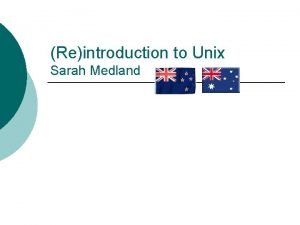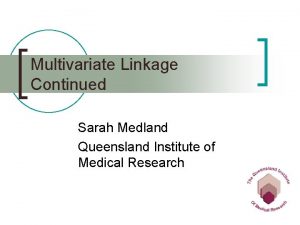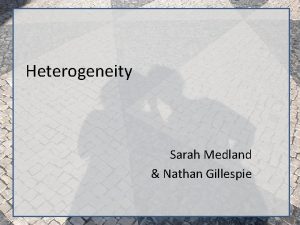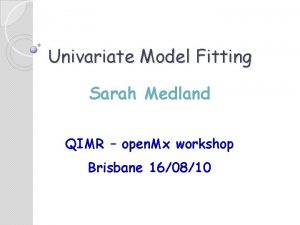Polygenic risk scores Sarah Medland Luca Colodro Conde















































- Slides: 47

Polygenic risk scores Sarah Medland Lucía Colodro Conde sarah/2020/thursday

What are Polygenic risk scores (PRS)? • PRS are a quantitative measure of the cumulative genetic risk or vulnerability that an individual possesses for a trait. • The traditional approach to calculating PRS is to construct a weighted sum of the betas (or other effect size measure) for a set of independent loci thresholded at different significance levels. • Typically the independence is LD based (LD r 2 <=. 2) via clumping.

The classics • Wray NR, Goddard, ME, Visscher PM. Prediction of individual genetic risk to disease from genome-wide association studies. Genome Research. 2007; 7(10): 1520 -28. • Evans DM, Visscher PM. , Wray NR. Harnessing the information contained within genome-wide association studies to improve individual prediction of complex disease risk. Human Molecular Genetics. 2009; 18(18): 3525 -3531. • International Schizophrenia Consortium, Purcell SM, Wray NR, Stone JL, Visscher PM, O'Donovan MC, Sullivan PF, Sklar P. Common polygenic variation contributes to risk of schizophrenia and bipolar disorder. Nature. 2009; 460(7256): 748 -52 • Evans DM, Brion MJ, Paternoster L, Kemp JP, Mc. Mahon G, Munafò M, Whitfield JB, Medland SE, Montgomery GW; GIANT Consortium; CRP Consortium; TAG Consortium, Timpson NJ, St Pourcain B, Lawlor DA, Martin NG, Dehghan A, Hirschhorn J, Smith GD. Mining the human phenome using allelic scores that index biological intermediates. PLo. S Genet. 2013, 9(10): e 1003919.

Further reading • Dudbridge F. Power and predictive accuracy of polygenic risk scores. PLo. S Genet. 2013 Mar; 9(3): e 1003348. Epub 2013 Mar 21. Erratum in: PLo. S Genet. 2013; 9(4). (Important discussion of power) • Wray NR, Lee SH, Mehta D, Vinkhuyzen AA, Dudbridge F, Middeldorp CM. Research review: Polygenic methods and their application to psychiatric traits. J Child Psychol Psychiatry. 2014; 55(10): 1068 -87. (Very good concrete description of the traditional methods). • Wray NR, Yang J, Hayes BJ, Price AL, Goddard ME, Visscher PM. Pitfalls of predicting complex traits from SNPs. Nat Rev Genet. 2013; 14(7): 507 -15. (Very good discussion of the complexities of interpretation). • Witte JS, Visscher PM, Wray NR. The contribution of genetic variants to disease depends on the ruler. Nat Rev Genet. 2014; 15(11): 765 -76. (Important in the understanding of the effects of ascertainment on PRS work). • Shah S, Bonder MJ, Marioni RE, Zhu Z, Mc. Rae AF, Zhernakova A, Harris SE, Liewald D, Henders AK, Mendelson MM, Liu C, Joehanes R, Liang L; BIOS Consortium, Levy D, Martin NG, Starr JM, Wijmenga C, Wray NR, Yang J, Montgomery GW, Franke L, Deary IJ, Visscher PM. Improving Phenotypic Prediction by Combining Genetic and Epigenetic Associations. Am J Hum Genet. 2015; 97(1): 75 -85. (Important for the conceptualization of polygenicity)

Traditional approach Wray et al (2014) J Child Psychol Psychiatry

https: //sites. google. com/broadinstitute. org/ ukbbgwasresults/

Traditional approach MUST BE INDEPENDENT Wray et al (2014) J Child Psychol Psychiatry

1×-. 02 + 2×. 01 + 1×. 002 + 0×. 03 + 2×. 025 AC GG AT CC TT βC=-. 02 βG=. 01 βA=. 002 βG=. 03 βT=. 025 Wray et al (2014) J Child Psychol Psychiatry Polygenic score: . 052 Effect size from GWAS

Main uses of PRS 1) Single disorder analyses 2) Cross-disorder analysis 3) Sub-type analysis

Single trait analyses

Moderated single trait analyses

Cross-trait analysis PRS-SCZ

Sub-type analysis

PRS and power The power of the predictor is a function of the power of the GWAS in the discovery sample (due to its impact on the accuracy of the estimation of the betas). “I show that discouraging results in some previous studies were due to the low number of subjects studied, but a modest increase in study size would allow more successful analysis. However, I also show that, for genetics to become useful for predicting individual risk of disease, hundreds of thousands of subjects may be needed to estimate the gene effects. ” (Dudbridge, 2013)

PRS and power For simple power calculations you can use a regression power calculator (for r 2 of up to 0. 5%). As a general rule of thumb you usually want 2, 000+ people in the target dataset. R AVENGEME (https: //github. com/Dudbridge. Lab/avengeme) Power calculator for discovery (GWAS) sample needed to achieve prediction of r 2 in target sample

Power of PRS analysis increases with GWAS sample size PGC-MDD 1: N=18 k max variance explained = 0. 08%, p=0. 018 PGC-MDD 2: N=163 k max variance explained =0. 46%, p= 5. 01 e-08 Colodro-Conde L, Couvy-Duchesne B, et al, (2017) Molecular Psychiatry

Making a PRS

(1) GWAS summary statistics From PGC results, other public domain GWAS, unpublished GWAS SNP identifier (rs number, Chr: BP ) Both Alleles (effect/reference, A 1/A 2) Effect • Beta from association with continuous trait • OR from an ordinal trait - convert to log(OR) • Z-score, MAF and N (from an N weighted meta-analysis) p-value (frequency of A 1)

(1) GWAS summary statistics From PGC results, other public domain GWAS, unpublished GWAS SNP identifier (rs number, Chr: BP ) Both Alleles (effect/reference, A 1/A 2) Effect • Beta from association with continuous trait • OR from an ordinal trait - convert to log(OR) • Z-score, MAF and N (from an N weighted meta-analysis) p-value (frequency of A 1) Make sure that your target genotypes are named the same way as your discovery data! imputation reference and genomic build

(2) Find SNPs in common with your local sample and QC • Imputed data • QC • R 2 >=0. 6 • MAF>=0. 01 • No indels • No ambiguous strands (*) - A/T or T/A or G/C or C/G for ((i=1; i<=22; i++)) do awk '{ if ($5<=. 01 & $5<=. 99 & $6>=. 6) print $1}’ file"$i". info >> available. snps done

(*) On ambiguous strands GWAS chip results are expressed relative to the + or – strand of the genome reference A/C T/G A/T T/A + rsxxx A C MAF rsxxx T G MAF rsxxx A T MAF rsxxx T A 1 -MAF + -

(3) Clumping • Select most associated SNP per LD region (pruning) • Plink 1. 9 --bfile Reference. Panel. For. LD --extract QCed. Listof. SNPs --clump gwas. File. With. Pvalue --clump-p 1 (#Significance threshold for index SNPs) --clump-p 2 (#Secondary significance threshold for clumped SNPs) --clump-r 2 (#LD threshold for clumping) --clump-kb (#Physical distance threshold for clumping) --out Output. Name

(4) Calculate risk scores The trait. X"$i". selected files will contain the lists of top independent snps. Merge the alleles, effect & P values from the discovery data onto these files. To do a final strand check merge the alleles of the target set onto these files. If any SNPs are flagged as mismatched you will have to manual update the merged file - flip the strands (ie an A/G snp would become a T/C snp) but leave the effect as is. Create Score files (SNP Effect. Allele Effect) and P files contain (SNP Pvalue). for ((i=1; i<=22; i++)) do awk '{ if ($6==$8 || $6==$9 ) print $0, "match" ; if ($6!=$8 && $6!=$9 ) print $0, "mismatch"}' trait. X. "$j". merged > strandcheck. trait. X. "$i" grep mismatch strandcheck. trait. X* done

(4) Calculate risk scores for ((i=1; i<=22; i++)) do plink --noweb --dosage Your_chr"$i". plink. dosage. gz format=1 Z --fam Your_chr"$i". plink. fam --score trait. X. "$i". score --q-score-file trait. X. "$i". P --q-scorerange p. ranges --out Your_chr"$i". PRS done p. ranges S 1 0. 000001 S 2 0. 00 0. 01 S 3 0. 00 0. 10 S 4 0. 00 0. 50 S 5 0. 00 1. 00

(5) Run PRS analysis –unrelated individuals base <- lm (ICV ~ age + sex + PC 1 + PC 2 +PC 3 +PC 4 + other-covariates, data =mydata) score 1 <- lm (ICV ~ S 1 + age + sex + PC 1 + PC 2 +PC 3 +PC 4 + other-covariates, data =mydata) score 2 <- lm (ICV ~ S 2 + age + sex + PC 1 + PC 2 +PC 3 +PC 4 + other-covariates, data =mydata) model_base <- summary(base) model_score 1 <- summary(score 1) model_score 2 <- summary(score 2) model_base$r. squared model_score 1$r. squared model_score 2$r. squared anova(base, score 1) anova(base, score 2)

(5) Run PRS analysis, controlling for relatedness – twin pairs or small families • You can add the PRS as a covariate on the means model in an open Mx script • Allows you to do multivariate PRS analyses • Or look at variance explained over time in longitudinal data • Test if the betas are equal across time points

(5) Run PRS analysis, controlling for relatedness in large/complex cohorts gcta --reml --mgrm-bin GRM --phenotype. To. Predict. txt --covar discrete. Covariates. txt --qcovar quantitative. Covariates. txt --out Output --reml-est-fix --reml-no-constrain Could run this analysis in a multilevel Open. Mx model

Other Methods

Classic / Clump and Threshold BLUP (LDpred) PRSice Dosage or best guess Best guess Dosage or best guess clumping BLUP effects summed over all SNPs clumping Multiple PRS by p-value thresholds Unique PRS All p-value thresholds tested Bonferroni correction Unclear significance threshold for association Hypothesis: effect sizes of SNPs normally distributed Fast (can be parallelized) Matrix inversion, can be long for large N Slower and harder to parallelize (R package) PLINK GCTA, PLINK R (PLINK)

Overlap and Overfitting

Q: How important is independence with Biobank size samples? • Perceptions that this may not matter with biobank type discovery samples when the overlap is very small • Impact of relatedness across the discovery and target samples is usually ignored

Q: How important is independence with Biobank size samples? • To examine this • GWAS were conducted for a continuous (height) • ~340, 000 individuals were extracted from the UK Biobank (app. 25331) • European Ancestry & Unrelated (less than 3 rd degree relatedness) • Age, Sex and 10 PCs included as covariates • A set of 35, 000 individuals held out to ensure independence of the target sample

Q: How important is independence with Biobank size samples? • Discovery GWAS were clumped and PRS were calculated • PRS analyses were conducted using target samples • of 2, 000, 5, 000 or 10, 000 individuals randomly drawn from the hold-out sample (of 35, 000) • 1, 000 replicates • 4 PRS thresholds: • 0. 0001 • Age, Sex and 10 PCs included as covariates • To examine overfitting the target samples were spiked with • 5, 10, 50, 100 or 200 overlapping individuals • 5, 10, 50, 100 or 200 1 st degree relatives

A: Variance explained • PRS analyses in independent samples explained a median of 11. 6% of variance

A: Impact of non-independent samples • Yes – as expected there is bias in the estimate of variance explained and the p values • Pattern of results the same across all Ns

A: Impact of non-independent samples • Inflation present • Extent is a function of the % overlap in the target sample • Confirms the cautions of Wray et al 2013 apply to biobank sized discovery samples • With 5 overlapping people in a target sample of 10 k there was significant inflation • Median CIs did not include 1

A: Impact of non-independent samples

A: Impact of non-independent samples • Inflation also present • In binary phenotypes • Even if the overlap is limited to only controls or only cases • Expect that inflation will be worse for quantitative traits if overlap is restricted to the tails of the distribution • (Not tested)

A: Impact of First Degree Relatives • Inflation present • Proportional to the h 2 and the extent of overlap in the target sample (% of N)

Q: How to Identify non-independence? • Homer et al method • Visscher and Hill 2009 more powerful • However, many cohorts do not provide true MAF, violates data access, not clear how well this really works with a realistic meta-analysis

Q: How to Identify non-independence? • LDScore – (Maybe, more work needed…) • Using the Height data from the PRS analyses ran GWAS for 20 permutations • Sample 1 340, 000 individuals • Sample 2 30, 000 individuals • Overlap of 200 individuals • Covariance “Intercept” ranged from. 067 (. 017) to. 075 (. 017) indicating nonindependence • Overlap of 5 individuals • Covariance “Intercept” ranged from. 062 (. 016) to. 072 (. 017) indicating nonindependence

WHAT Are the Solutions if you find non-independence • Homer et al method • Visscher and Hill 2009 more powerful • However, many cohorts do not provide true MAF, violates data access, not clear how well this really works with a realistic meta-analysis

WHAT Are the Solutions if you find non-independence • Homer et al method • Visscher and Hill 2009 more powerful • However, many cohorts do not provide true MAF, violates data access, not clear how well this really works with a realistic meta-analysis

WHAT Are the Solutions if you find non-independence • Leave-one-out… • If both groups have raw data access collaborate & exchange checksums • Make list of common non-ambiguous SNPs passing QC in discovery and target • Make n SNP set lists each with m SNPs • Export hardcall data from each SNP set (1 line person but no IDs) • Parse the data obtaining a checksum for each line of data • Exchange and look at % of identical checksums Google: checksum ripke https: //personal. broadinstitute. org/sripke /share_links/checksums_download/

WHAT Are the Solutions if you find non-independence • Mak et al (2018) proposed using all available data in the discovery and use of cross-prediction with split-validation to reduce inflation • Focus is on situations where you have raw data for both discovery and target • They do not consider the more typical situation where you have discovery sum-stats and raw target data

WHAT Are the Solutions if you find non-independence • Do you really need prediction • Are you trying to show polygenicity? • If not can you answer your question with LDSC, GWAS-SEM, MR, SECA or another approach?

Questions?
 Sarah medland
Sarah medland Altramueces
Altramueces Typologies are nominal composite measures
Typologies are nominal composite measures Polygenic inheritance
Polygenic inheritance Define pleiotropic gene
Define pleiotropic gene Polygenic inheritance
Polygenic inheritance Polygenic inheritance
Polygenic inheritance Butrwr
Butrwr Market risk credit risk operational risk
Market risk credit risk operational risk Braden score meaning
Braden score meaning Sarah risk assessment
Sarah risk assessment O enterro do conde de orgaz
O enterro do conde de orgaz Transferencia tecnologica
Transferencia tecnologica Conde lucanor ejemplo 35
Conde lucanor ejemplo 35 A quien apodaban bola de sebo
A quien apodaban bola de sebo Cantar del mio cid argumento
Cantar del mio cid argumento Enxiemplos del conde lucanor
Enxiemplos del conde lucanor Ies conde diego porcelos
Ies conde diego porcelos Caracteristicas de mio cid
Caracteristicas de mio cid Romance del conde olinos letra
Romance del conde olinos letra Conde d'eu
Conde d'eu Annimo
Annimo El conde lucanor: consejero patronio don juan manuel
El conde lucanor: consejero patronio don juan manuel Musée condé
Musée condé Manoel conde
Manoel conde Eduardo conde
Eduardo conde Proceso social
Proceso social El romance del conde olinos
El romance del conde olinos Moro moro sa panahon ng kastila
Moro moro sa panahon ng kastila Conde nast
Conde nast Alvaro peralta conde
Alvaro peralta conde El conde lucanor poema
El conde lucanor poema Gologie
Gologie Carnicería javier
Carnicería javier Abacera
Abacera Moraleja de el conde lucanor ejemplo 35
Moraleja de el conde lucanor ejemplo 35 Relative risk and attributable risk
Relative risk and attributable risk Residual risk and secondary risk pmp
Residual risk and secondary risk pmp Medium-term risk examples
Medium-term risk examples Key risk indicators financial risk management
Key risk indicators financial risk management Risk projection attempts to rate each risk in two ways
Risk projection attempts to rate each risk in two ways Risk map
Risk map Inherent risks examples
Inherent risks examples Risk financing adalah
Risk financing adalah Ar = ir x cr x dr
Ar = ir x cr x dr Risk management avoidance
Risk management avoidance Relative risk
Relative risk Absolute risk vs relative risk
Absolute risk vs relative risk


